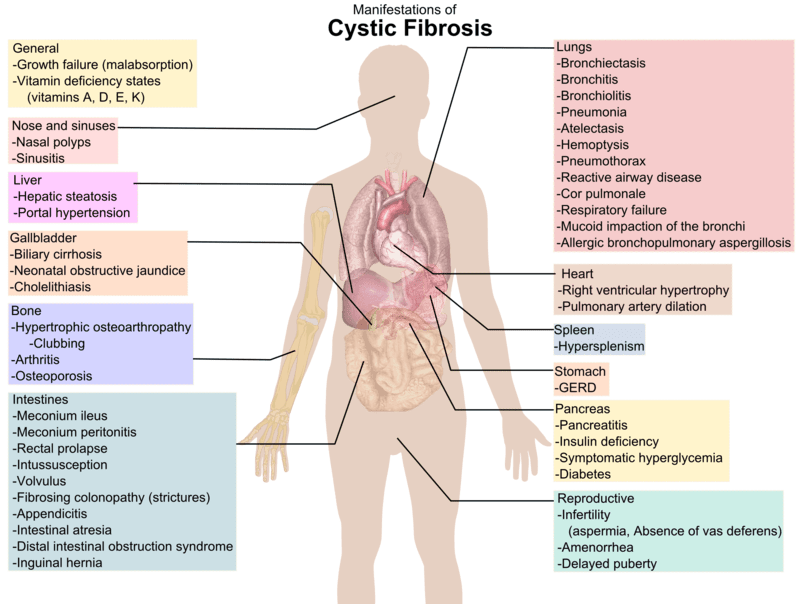Difference Between Cystic Fibrosis and Pulmonary Fibrosis
Key Difference – Cystic Fibrosis vs Pulmonary Fibrosis
The key difference between Cystic Fibrosis and Pulmonary Fibrosis is that Cystic fibrosis is a genetic disorder where multiple organs including lungs, gastrointestinal system, pancreas as well as the genital system are affected while lung fibrosis is a condition characterized by gradual fibrosis of the lung parenchyma causing defects in the gas diffusion leading to respiratory failure at later stages.
What is Cystic Fibrosis?
Cystic fibrosis is an autosomal recessive disorder causing mutations of both copies of the gene responsible for the protein called cystic fibrosis transmembrane conductance regulator (CFTR). This protein is involved in the production of sweat, digestive secretions, and mucus. When this protein is not functioning, secretions become thick. This disorder is characterized by the formation of thick mucus and intestinal secretions causing blockage of the duct systems of different organs causing their dysfunctions. Typical symptoms include pancreatic insufficiency due to the chronic obstruction of the pancreatic ducts, intestinal obstruction, and frequent lung infections due to the dysfunction of the mucociliary apparatus and infertility due to the obstruction of the duct in the genital system.Cystic fibrosis is diagnosed by a sweat testing and genetic analysis.
There is no known cure for this disorder. Lung infections are frequent and need to be treated with appropriate antibiotics to prevent long-term damage to the lungs. The patient may need to be given prophylactic antibiotics to prevent infections as well. Lung transplantation may be the ultimate option for a severely damaged lung.Pancreatic enzyme replacement is important to prevent malnutrition. Lung problems are responsible for the death in most patients with cystic fibrosis.
Cystic fibrosis is common among people of European ancestry.
What is Pulmonary Fibrosis?
Pulmonary fibrosis is a group of disorders characterized by gradual fibrosis and destruction of the lung. Patients with pulmonary fibrosis suffer from shortness of breath, especially with exertion, dry cough, fatigue, and weakness. There are a number of causes responsible for pulmonary fibrosis.
Inhalation of environmental and occupational pollutants such as asbestos, silica and exposure to certain noxious gasses.
- Hypersensitivity pneumonitis resulting from inhaling dust contaminated with bacterial, fungal products
- Connective tissue diseases such as rheumatoid arthritis and systemic lupus erythematosus
- Cigarette smoking
- Sarcoidosis
- Infections
- Certain medications, e.g. amiodarone, methotrexate, nitrofurantoin
- Chest radiation therapy
However, there is a category of pulmonary fibrosis where the cause is not found. This group is named as idiopathic pulmonary fibrosis.
Most important mode of treatment is the avoidance of the exposure to the cause. Otherwise, no effective treatment is available to prevent the progression of this disease. Patients will finally end up with respiratory failure where lung transplantation is the only option.
What is the difference between Cystic Fibrosis and Pulmonary Fibrosis?
Definition of Cystic Fibrosis and Pulmonary Fibrosis
Cystic fibrosis: Cystic fibrosis (CF) is an inherited disease that affects the lungs, digestive system, sweat glands, and male fertility.
Pulmonary fibrosis: Pulmonary fibrosis is scarring in the lungs.
Characteristics of Cystic Fibrosis and Pulmonary Fibrosis
Age Distribution
Cystic fibrosis: Cystic fibrosis is a congenital disorder and present from birth
Pulmonary fibrosis: Pulmonary fibrosis is seen among middle-aged and elderly population
Ethnic Distribution
Cystic fibrosis: Cystic fibrosis is seen in European population but extremely rare among other ethnic groups.
Pulmonary fibrosis: No ethnic diversity for lung fibrosis and affect all ethnic groups.
Causes
Cystic fibrosis: Cystic fibrosis is caused by a mutation in a gene.
Pulmonary fibrosis: Pulmonary fibrosis is caused by many environmental causes than genetic causes.
Symptoms Distribution
Cystic fibrosis: Cystic fibrosis affects many organ systems of the body including gastrointestinal, respiratory and genitourinary.
Pulmonary fibrosis: Pulmonary fibrosis is confined to the respiratory system.
Complications
Cystic fibrosis: Extrapulmonary complications are commoner with cystic fibrosis.
Pulmonary fibrosis: While extrapulmonary complications are less common with pulmonary fibrosis.
Investigations
Cystic fibrosis: Cystic fibrosis is diagnosed by sweat tests and genetic tests.
Pulmonary fibrosis: Pulmonary fibrosis is diagnosed by high-resolution CT scans (HRCT)
Treatment
Cystic fibrosis: Cystic fibrosis is treated by supportive treatment including antibiotics.
Pulmonary fibrosis: Pulmonary fibrosis doesn’t have successful treatment option but, steroids have a role in preventing progression to fibrosis at acute inflammatory stage and home oxygen therapy and pulmonary rehabilitation at latter stages.
Prognosis
Cystic fibrosis: For cystic fibrosis prognosis is poor and patient usually die due to respiratory infection.
Pulmonary fibrosis: Pulmonary fibrosis usually has a slow progression however patients ultimately end up in irreversible respiratory failure where they become oxygen dependent.
Reference cystic fibrosis. (n.d.) Gale Encyclopedia of Medicine. (2008). Retrieved August 13 2015 from http://medical-dictionary.thefreedictionary.com/cystic+fibrosis pulmonary fibrosis. (n.d.) Gale Encyclopedia of Medicine. (2008). Retrieved August 13 2015 from http://medical-dictionary.thefreedictionary.com/pulmonary+fibrosis Image Courtesy: “Cystic fibrosis manifestations” by Maen K Abu Househ – Own work, and this is a derivative work from this file that was originally made by User:Mikael HäggströmReferenceNelson essentials, text book of pediatrics [1]↑ Kliegman, Robert; Richard M Kliegman (2006) Nelson essentials of pediatrics, St. Louis, Mo: Elsevier Saunders ISBN: 0-8089-2325-0.. Licensed under Public Domain via Wikimedia Commons “Ipf NIH” by National Heart Lung and Blood Institute (NIH) – National Heart Lung and Blood Institute (NIH). Licensed under Public Domain via Wikimedia CommonsncG1vNJzZmivp6x7pbXFn5yrnZ6YsqOx07CcnqZemLyue8OinZ%2Bdopq7pLGMm5ytr5Wau26v2Kyroptdm7ajvs6soKxlkaOxbsLSZqeupJ2ku6K%2B2GadopqipMCqv44%3D